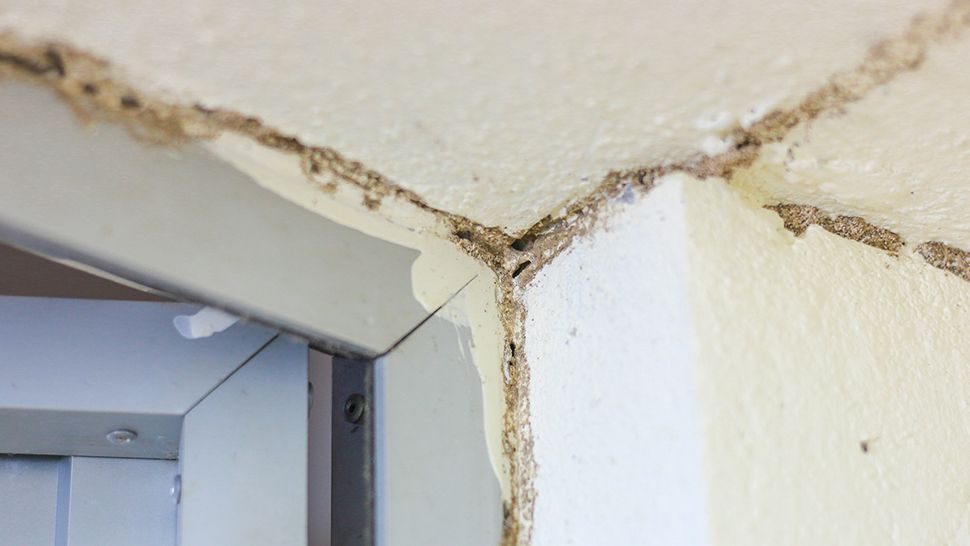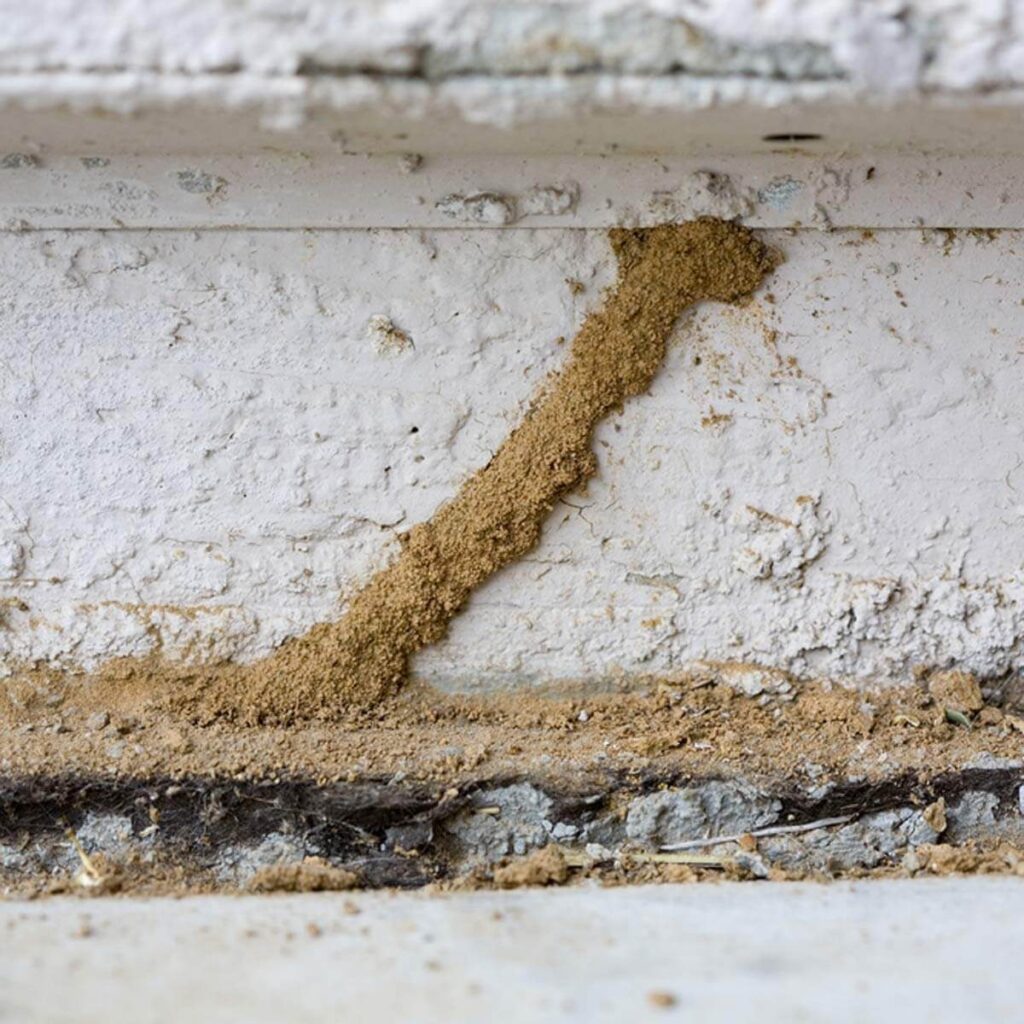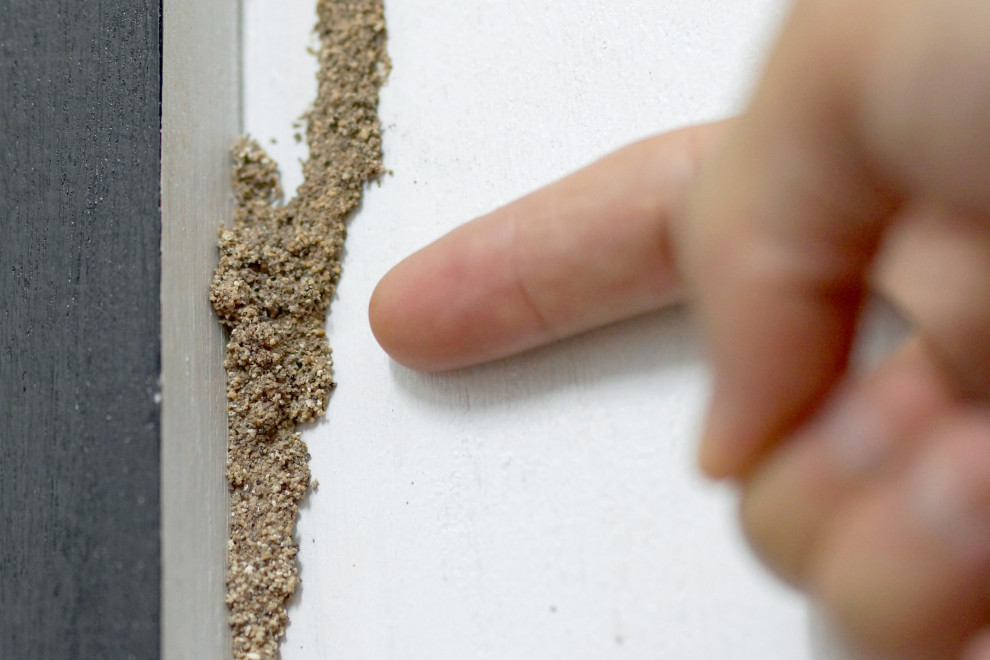Here are the prompt steps that you must take to treat the termites in walls:
- Identify the termite infestation by looking for mud tubes, damaged wood, or discarded wings.
- Get in touch with a professional pest control service for a comprehensive inspection and a treatment plan.
- Treat termites in walls using methods such as liquid termiticides or bait stations.
- Repair any damaged wood or structural issues caused by the termites.
- Implement preventive measures like regular inspections and maintaining a termite barrier.
Treating Termites in Walls: Signs of Termite Infestation in Walls

Termites are troublesome insects that can silently damage your home’s structure. It’s crucial to act swiftly to prevent further damage when they infest your walls.
Before treating the termites in the wall, you must explore the signs of termite infestations.
- Visual Indicators
Mud Tubes: Termites often build mud tubes on the walls, resembling tiny tunnels. These tubes protect them from drying out and provide easy access to wood. To treat termites, first, identify and scrutinize these mud tubes.
Frass: Termite droppings, known as frass, may accumulate near infested areas. It looks like tiny wood-colored pellets. If you spot frass, it’s a clear sign of termite activity in your walls.
Damaged Wood: Check for wood damage. Termites feed on wood from the inside, leaving a thin layer on the surface. Tap the wood gently; if it sounds hollow or breaks easily, termites may be to blame.
B. Auditory Signs
Termites are often quiet pests, but you can sometimes hear them if you listen carefully. They create a soft, rustling noise while munching on wood. Press your ear against the wall or use a stethoscope
Treating Termites in Walls: Identifying the Type of Termites
Before treating termite infestations in walls, it’s essential to identify the type of termite present. Two common types are subterranean and dry wood termites.
Understanding their differences in behavior and characteristics will guide you toward effective treatment.
A. Differentiating between Subterranean and Drywood Termites
Subterranean Termites:
Location: Subterranean termites live in the ground, often building mud tubes to access structures.
Entry Points: They enter buildings through soil-to-wood contact or cracks in foundations.
Wood Damage: Subterranean termites prefer softwood and usually damage wood near the ground.
Mud Tubes: Look for mud tubes on walls or foundations, indicating subterranean termite activity.
Swarmers: These termites have dark bodies with wings of varying lengths.
Drywood Termites:
Location: Drywood termites live within the wood they infest, so they don’t need soil contact.
Entry Points: They enter through infested wood or furniture, making them less dependent on soil contact.
Wood Damage: Drywood termites can damage wood throughout the structure.
No Mud Tubes: Unlike subterranean termites, dry-wood termites do not construct mud tubes.
Swarmers: Drywood termite swarmers have a reddish-brown body with wings of equal length.
B. Understanding the Behavior and Characteristics of Each Type
Subterranean Termites:
Colony Size: Subterranean termite colonies are typically larger, with thousands to millions of members.
Moisture Dependence: They need moisture for survival and often build mud tunnels to maintain it.
Behavior: Subterranean termites are more aggressive and can quickly cause severe structural damage.
Control Methods: Effective control often involves treating soil around the structure to create a barrier against it.
Drywood Termites:
Colony Size: Drywood termite colonies are smaller, with hundreds to thousands of members.
Moisture Dependence: They require less moisture than subterranean termites and can survive in dry wood.
Behavior: Drywood termites infest wood without the need for soil contact, making them harder to detect.
Control Methods: Treatment typically involves localized or whole-structure fumigation or spot treatments.
Identifying the type of termites infesting your walls is crucial in effective treatment.
Subterranean and drywood termites have distinct characteristics and behaviors. Subterranean termites are more common and often require soil treatments, while drywood termites may necessitate localized or whole-structure fumigation.
Proper identification ensures that you can target the specific termite species infesting your walls, leading to a more successful termite eradication process.
Treating Termites in Walls: DIY Methods
When you discover termite infestations in your walls, you can act with these do-it-yourself (DIY) methods. These steps can help mitigate the problem until you can consult a professional for more extensive treatment.
A. Exposing Infested Areas and Removing Damaged Wood
Locate the Damage: Carefully inspect your walls for termite damage, including mud tubes, frass, or hollow-sounding wood.
Expose Infested Areas: Remove the wall coverings (such as drywall or paneling) to expose the infested wood. This allows you to assess the extent of the damage.
Remove Damaged Wood: Cut out and discard the infested wood sections. Be sure to dispose of it properly, as termites may still be present.
B. Applying Termite-Killing Solutions Directly to the Affected Walls
Boric Acid: Make a paste by mixing boric acid with water and applying it to the affected wood to eliminate termites, as boric acid is harmful to them.
Orange Oil: Orange oil has substances that can instantly kill termites. Apply it to the affected areas with a syringe or dropper.
Nematodes: Nematodes are tiny worms that eat termites. Buy them and put them in the soil around your home, especially near walls with termites.
C. Utilizing Termite Baits and Traps
DIY Bait Stations: Create your termite bait stations by placing strips of untreated wood near the infested areas. Check these stations regularly for signs of termite activity and replace the wood as needed.
Cardboard Traps: Termites are attracted to cardboard. Wet some cardboard and place it near termite-infested areas. Once it’s infested, remove and destroy it.
Important Considerations:
- DIY methods may provide temporary relief but may not fully eradicate the termite colony.
- Always wear protective gear when handling chemicals.
- DIY treatments are most effective for small, localized infestations.
Treating Termites in Walls: Professional Treatment Options
When dealing with a termite infestation in your walls, it’s often best to rely on the expertise of professional pest control companies. Here, we’ll explore the steps involved in hiring these experts and the treatment options they provide.
A. Hiring a Pest Control Company Specializing in Termite Eradication
Research: Research reputable pest control companies in your area specializing in termite eradication. Look for reviews and testimonials to gauge their reliability.
Get Multiple Quotes: Contact several companies and request quotes for termite treatment. Check prices and services to make a smart decision.
B. Evaluation and Recommendation of Appropriate Treatment Methods
Inspection: A skilled pest control expert will inspect your property, including the walls, to see how bad the termite problem is.
Identification: They will identify the type of termites involved, as different species may require different treatment approaches.
Treatment Recommendation: Based on their findings, the pest control expert will recommend the most appropriate treatment methods for your specific situation.
C. Consideration of Chemical and Non-Chemical Treatments
Chemical Treatments:
Liquid Termiticides: These chemicals are applied to the soil around your home to create a protective barrier, preventing termites from entering.
Termite Bait Systems: Stations with termite bait are strategically placed around your property. Termites eat the bait and take it to their nest, wiping out the whole colony.
Non-Chemical Treatments:
Heat Treatment: In some cases, professionals may use heat to raise the temperature within the infested walls, effectively killing termites.
Fumigation: Fumigation may be recommended for severe infestations or when the termites are inaccessible. This involves enclosing the entire structure and introducing a gas to eradicate termites.
Important Considerations:
- Professional treatments are more effective for extensive termite infestations or when multiple colonies are present.
- These treatments may come with warranties, providing long-term protection.
- Regular inspections and preventive measures are essential after professional treatment to prevent future infestations.
Treating Termites in Walls: Preventive Measures

Preventing future termite infestations in your walls is as important as treating the current problem. Here, we’ll explore effective preventive measures that can help you avoid termite troubles in the future.
A. Regular Inspection and Maintenance of Wood Structures
Annual Inspections: Schedule annual termite inspections by a pest control professional. Early detection can prevent extensive damage.
Wood Maintenance: Repair or replace any damaged or decaying wood promptly. Termites are attracted to weakened wood.
Seal Cracks and Gaps: Seal cracks and gaps in your home’s foundation and walls. Termites can use these as entry points.
B. Managing Moisture Levels to Discourage Termite Activity
Fix Leaks: Repair any water leaks promptly. Termites thrive in moist environments.
Proper Drainage: Ensure proper drainage away from your home’s foundation. This helps prevent soil moisture buildup.
Ventilation: Maintain good ventilation in crawl spaces and attics to reduce humidity levels.
C. Creating Physical Barriers and Protective Treatments
Termite-Resistant Building Materials: Consider using termite-resistant building materials when constructing or renovating your home. These materials are less attractive to termites.
Chemical Barriers: Hire a pest control professional to install chemical barriers around your home’s perimeter. These barriers discourage termites from approaching.
Termite Shields: Install physical termite shields or metal barriers where wood comes into contact with soil or masonry. This prevents direct access to the wood.
Important Considerations:
- Regular maintenance and vigilance are key to preventing termite infestations.
- Keep firewood, mulch, and other wood-based materials away from your home’s foundation.
- Consider professional guidance for preventive treatments and materials.
FAQs
What are the signs of termites on my walls?
Termites leave behind several telltale signs, including mud tubes, discarded wings, hollow-sounding wood, and tiny exit holes in wooden structures.
Can I treat termites in my walls myself?
Yes, you can treat termites in your walls yourself using DIY methods, but for extensive infestations, it’s advisable to consult a professional pest control expert.
What is the cost of termite treatment for walls?
The cost varies depending on the severity of the infestation, the treatment method, and the size of your home. Professional termite treatment can range from a few hundred to several thousand dollars.
How long does it take to treat termites in walls?
Treating wall termites usually takes 7 to 21 days, depending on factors like termite type, infestation size, and treatment method. Complete eradication can take anywhere from a few days to several weeks.
Are there eco-friendly options for termite treatment in walls?
Yes, some environmentally friendly termite treatments are available, such as baiting systems that minimize the use of chemicals.
Do I need to vacate my home during termite treatment?
In most cases, you can remain in your home during treatment, but you may need to leave if extensive fumigation is required temporarily. Your pest control professional will provide guidance.
How can I prevent termites from getting into my walls in the future?
Preventive measures include regular inspections, maintaining proper drainage, reducing wood-to-soil contact, and using termite-resistant building materials.
Do insurance policies cover termite damage in walls?
No, standard homeowners’ insurance policies typically do not cover termite damage in walls as it is considered preventable and not a sudden or accidental event.
Are there any health risks associated with termite treatments in walls?
Yes, Termite treatments in walls may have health risks from chemicals, but professionals usually use them safely, keeping the risks low and manageable.
Can termites come back after treatment?
Yes, termites can return after treatment if preventive measures are not followed. Furthermore, new infestations may occur due to external factors like nearby termite colonies.
Conclusion
Treating termites in walls requires prompt action and professional expertise. Identifying visual indicators and, in some cases, auditory signs can help you catch the problem early.
DIY methods are essential for treating termite problems as they give homeowners immediate action and control over the situation. Waiting too long to treat termites can lead to severe damage and costly repairs.
DIY methods allow homeowners to address the issue promptly and minimize the potential for further damage. It is imperative to act quickly and effectively to prevent termites from inflicting more destruction on the walls of a home.

